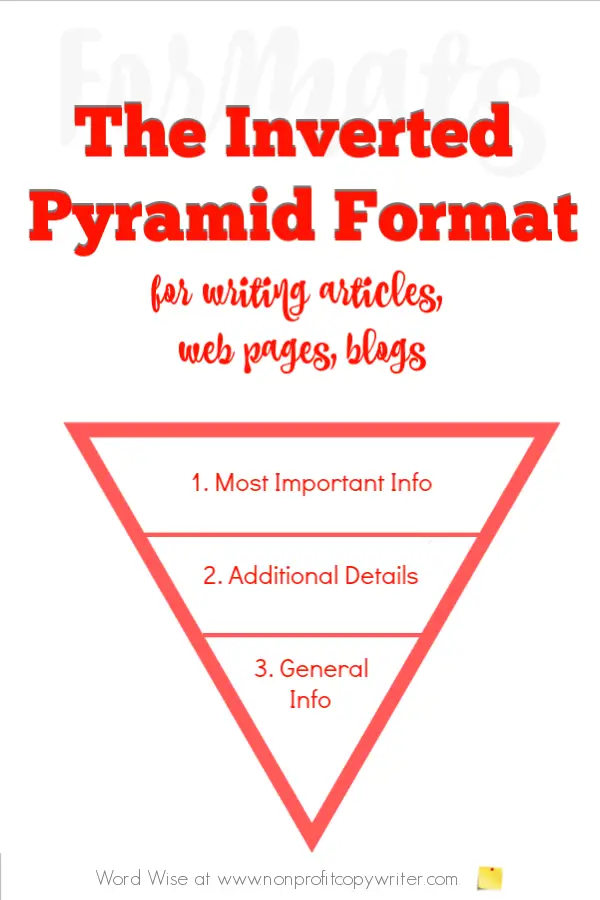Save Time: Get 5 Simple Writing Tips
you can put to use in 10 minutes
The Inverted Pyramid: Use This Article Writing Format for Online Content, Too
Award-winning writer Kathy Widenhouse has helped hundreds of nonprofits and writers produce successful content , with 750K+ views for her writing tutorials. She is the author of 9 books. See more of Kathy’s content here.
Updated 5.30.24
The Inverted Pyramid is an article writing format that places the most important information at the top of the piece.
It’s a structure you see all the time in news reports.
You get a summary of the story at the top with details to follow.
In fact, the Inverted Pyramid is sometimes called a Summary News Lead Style or Bottom Line Up Front (BLUF).
I like how the Inverted Pyramid gives you a visual image of how to present the content of your piece. Think of an equilateral triangle that’s pointed down.
How to Organize Article Writing Using the Inverted Pyramid
The key to using this format in article writing is to prioritize your information. Organize your content in three buckets of descending levels of importance.
- Bucket #1: What is absolutely necessary for the reader to know about your topic? The basics of the article go in Bucket #1. Use the who, what, where, when, why, and how, combined in a sentence or two ,to write a summary lead. Or go the BLUF approach and open with your conclusion first.
- Bucket #2: Add other important details.
- Bucket #3: Expand your article premise with general or background information.
Use the Front-Loading Principle Throughout the Piece
The Inverted Pyramid is a direct approach – one that is much different than essay writing, which begins with a problem statement and proceeds through a persuasive argument to a conclusion.
Instead, the Inverted Pyramid opens with your point. You use the rest of the article to explain it. This way your reader can read just one sentence and get the gist of your article.
It’s a method you can use in all article writing elements.
Front-Load Your Lead
- Choose one main point or conclusion for your article
- Start the article with your summary sentence
- Explain elements of your point in the sections of the article, one at a time
Front-Load Each Section
- Choose one main point for each section
- Start the section with your summary sentence
- Explain your point
Front-Load Your Headlines and Subheads
- Place significant words at the beginning of your headings
- Use the heading to communicate the topic of the section
- Scan headings in succession to get the gist of the piece
Why the Inverted Pyramid Is Ideal for Online Content
The Inverted Pyramid format has been widely adopted from article writing to online writing, particularly in web pages, blogs, and in emails.
It’s easy to see why: it uses the principle of front loading throughout the piece.
- Readers start at the top. Front-loading places your main point at the top of the page, above the fold, so readers get the main point even if they don’t finish the piece.
- Readers skim online. Front-loaded content allows them to decide whether or not they want to read the entire page or post.
- Readers scan online content. Front-loading allows them to read subheads to get a quick overview.
- Readers find your content from keywords. Front-loading ensures that your main point and page keywords are at the top of the page, which allows search engines to find you and direct readers to your content.
You’ll always have visitors who read every single word of your post or page. But for the vast majority of the rest, you face a question: do you want them to get the gist of what you have to say on your web page, blog, or email?
If your answer is yes, then make it easy for them to do so when you front load your content.
More about Article Writing
Learn To Write Content When You Learn To Write an Article ...
How to Write An Article: Get Started With These 12 Steps ...
How to Choose an Article Topic...
Writing Articles FAQs: Frequently Asked Questions ...
How to Write an Article Introduction Faster ...
8 Types of Leads that Pull in Readers ...
What Is a Feature Article? Think News Story on Steroids ...
Choose a Story Angle Using These 3 Tips ...
6 Types of Articles New Freelancers Can Get Paid to Write ...
Write an Article or Write a Book? Here’s How to Decide ...
Article Writing Tips: News Story vs Feature Story – What’s the Difference?
How to Write a How To Article that gets read from start to finish ...
What's a Listicle and How Do I Write One?
Top Article Writing Tip: the One-Point Rule ...
How to find the main idea of your article before you write ...
Writing Blogs vs. Writing Articles: Is There a Difference?
How to Write an Introduction (or Lead, Lede, Hook) ...
Online Writing: How It Is Unique ...
Tips on Writing a Blog: 5 Blogging Myths Busted ...
Writing Articles Tips on our Pinterest board ...
As an Amazon Associate I earn from qualifying purchases.
Share This Page

Named to 2022 Writer's Digest list
BEST GENRE/NICHE WRITING WEBSITE


Stop Wasting Time!
Grab your exclusive FREE guide, "5 Simple Writing Tips You Can Put to Use in 10 Minutes or Less"












